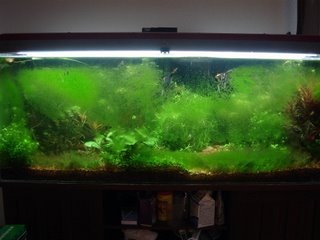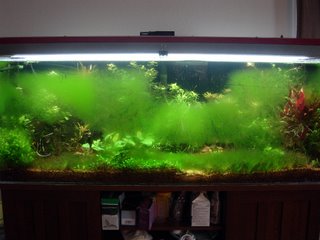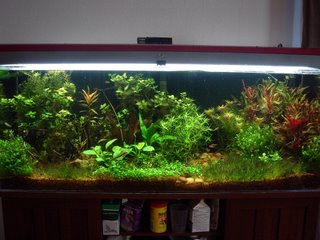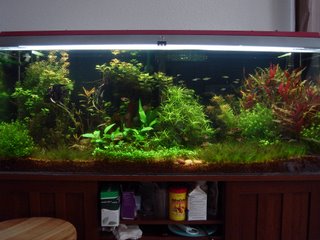Angelfish spawn for first time
- pH: 6.5
- Temp: 76-78
- KH:
- GH:
- NH4:
- NO2:
- NO3: 1
- PO4: 1.25
- Iron:
- Dosing: 5 mL Flourish, 0.5 ppm iron chelate, 17.5 ppm NO3, 0.8 ppm PO4, (5 mL Flourish and 0.5 ppm iron chelate yesterday)
- NO3:PO4 Cumulative Dosing Ratio: 42.5:3.5 = 12.1
Notes:
The angelfish pair spawned for the first time today! They started at around 11 am and finished a couple hours later.
 I currently am letting the green dust algae grow on the tank walls in order to try to eradicate it (see previous posts), so it was difficult to find a clear patch of tank wall to snap the picture of the eggs. Every time I pointed the camera at the tank, one of the angel fish would try to drive me off like I was a paparazzi. The mother is the one who's trying to attack me, the male is in the back.
I currently am letting the green dust algae grow on the tank walls in order to try to eradicate it (see previous posts), so it was difficult to find a clear patch of tank wall to snap the picture of the eggs. Every time I pointed the camera at the tank, one of the angel fish would try to drive me off like I was a paparazzi. The mother is the one who's trying to attack me, the male is in the back.The larger, mostly black female (now I know which is which) laid eggs on a large leaf of the Kleiner Bar sword plant, while the slightly smaller, more silver marked male followed her, fertilizing the eggs. Apart from which fish lays the eggs, you can tell the male and female apart by their "papilla" or the sexual organ which protrudes from the ventral side of the body during spawning: the female has a larger and more blunt papilla, while the male has a smaller, pointier papilla. After the female laid her eggs, the male brushed his papilla against the eggs several times. Sometimes, eggs would get dislodged from the leaf, and I've seen both the male and female eat eggs that come loose from the leaf. I also noticed that the female like to clean the leaf in between egg laying passes. She will also take eggs in her mouth if they come loose, but instead of eating them, she will often reposition the eggs back onto the leaf. The male is often busy chasing away any fish that come to close. It looked like the female ended up laying roughly around a couple hundred eggs.
I purchased the two angelfish together several months ago when they were juveniles (about the size of a nickel), and their markings are so similar that I suspect that they are probably siblings. I don't know what problems that could cause breeding wise!
Some resources:
http://websvirginia.com/angels/
http://www.angelsplus.com/Breeding.htm
I noticed that the pH was 6.5, because the CO2 bubble rate had crept up (2.5 b/s). I lowered it back down to about 1.9 b/s.







